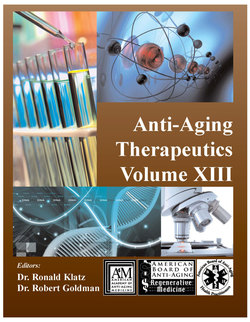Читать книгу Anti-Aging Therapeutics Volume XIII - A4M American Academy - Страница 48
На сайте Литреса книга снята с продажи.
Alzheimer’s Disease and Senile Dementia
ОглавлениеIt is difficult to overestimate the impact of Alzheimer’s disease (AD), with some 5 million cases in the U.S. and the “baby boom” demographic curve entering old age. The financial and social costs are incalculable, but certainly count in the billions of dollars. According to a recent consensus panel report from the U.S National Institutes of Health (NIH), “firm conclusions cannot be drawn about the association of any modifiable risk factor with cognitive decline or Alzheimer’s disease” and “evidence is insufficient to support the use of pharmaceutical agents or dietary supplements to prevent cognitive decline or Alzheimer’s disease.”
Progress has been made however in understanding the etiology of AD, notably the association of the apolipoprotein E (ApoE) gene variation, and misfolded beta amyloid plaques that characterize the neuropathology of the disease. Certain lifestyle factors have an association with lowered incidence of AD, including physical activity, higher educational attainment, cognitive engagement behaviors, adequate folic acid intake, low dietary saturated fat, and high fruit and vegetable consumption. The NIH panel report does include a mention of low-to-moderate alcohol consumption as having a favorable impact on risk, but with a focus on wine specifically a clearer picture emerges. In fact, every large-scale epidemiologic survey that included a question on wine consumption has found a clear reduction in incidence among wine drinkers – up to 80% lower. A representative study is the Gruppo Italiano multicenter survey of more than 15000 subjects who underwent cognitive testing, with the highest scores in men drinking up to a liter of red wine per day and women consuming half that amount.11 The resulting J-shaped curve did not show an increase in cognitive decline until more than 2 liters daily consumption (for men) was reached. This dramatic relationship not only confirms the consistent relationship of wine consumption to lower incidence of AD, but suggests a powerful protective constituent to counter the adverse neural effects of high levels of alcohol consumption.
Resveratrol has emerged as a potential explanation for wine’s protective effects against AD, though other wine phenolics have been reported to have significant roles as well. In animal models, resveratrol has been shown to promote clearance of beta amyloid from neural tissues, and to be a potent inhibitor of beta amyloid deposition.12 Resveratrol is also a neuroprotectant, countering the toxic effects of beta amyloid in experimental models. This effect appears to be specific and unrelated to its antioxidant capacity. Whether or not therapeutic levels of resveratrol within the central nervous system can be achieved remains a matter of speculation however.
Via separate pathways, resveratrol may enhance neural function by up-regulation of MAP kinases active in the learning and memory centers of the brain. One small clinical study showed a dose-dependent increase in cerebral blood flow and increase in oxygen extraction by the brain with cognitive testing after taking resveratrol as compared to placebo, though no improvement in test scores was achieved.13 This, along with the findings in the gerbil global cerebral ischemia study, suggest that some degree of activity with central nervous system tissue can be achieved with resveratrol, though the cognitive testing results may be related to vasodilation rather than a neural effect. Long-term clinical trials will be required in order to obtain high-level evidence for a role of resveratrol in reducing age-related cognitive decline. A handful of these are underway, though results will likely be years off.
